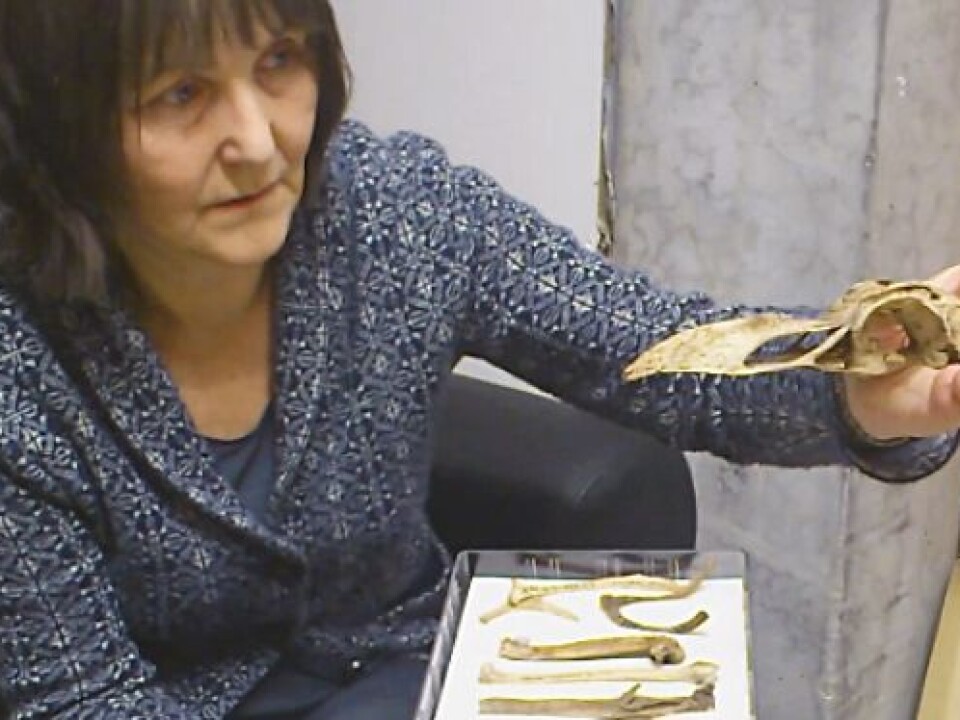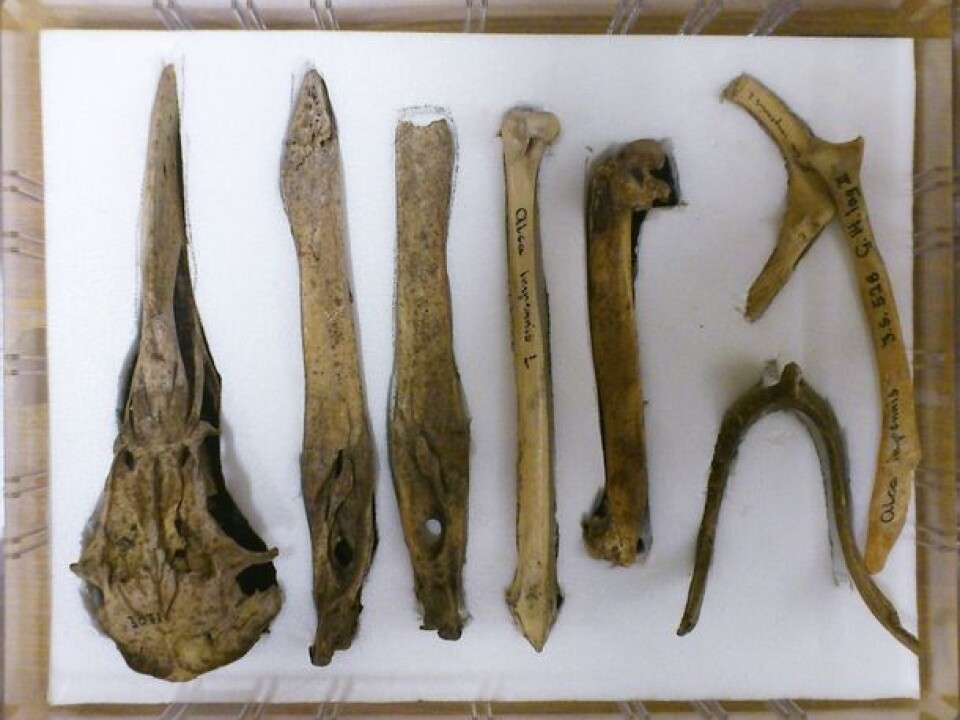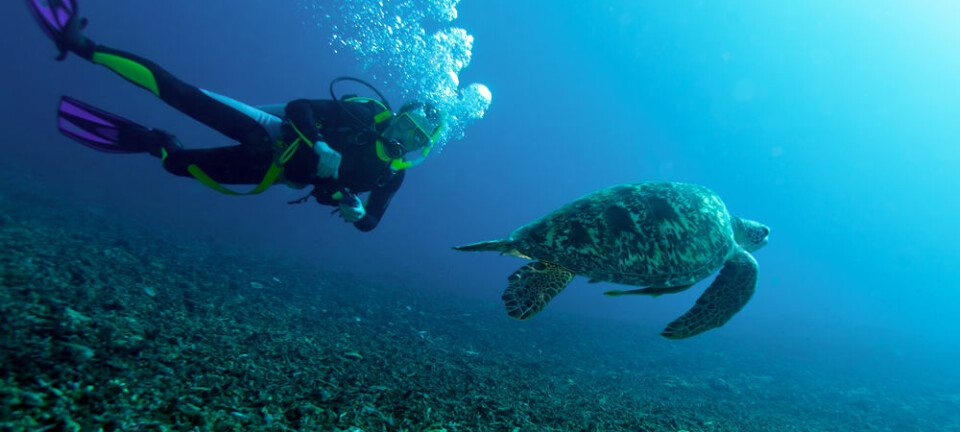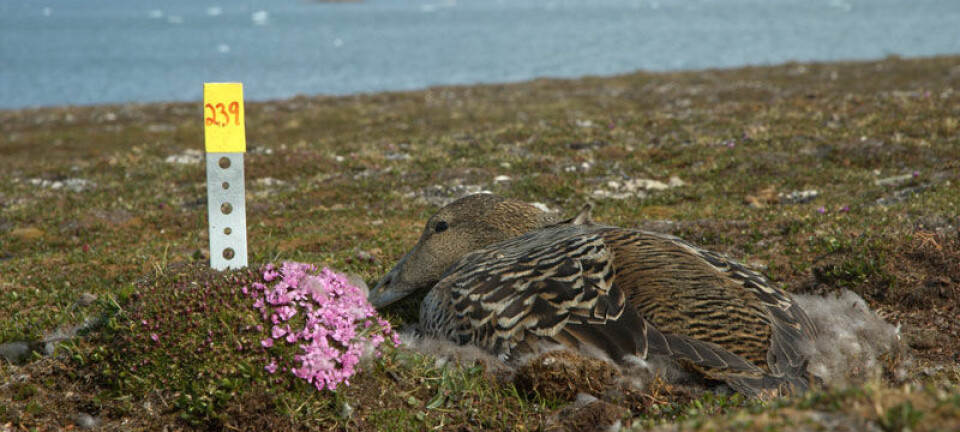
The giant that perished
The largest known razorbill, or auk, was a powerful swimmer that couldn’t fly. Our ancestors carved images of the Great Auk in caves 35,000 years ago. But in the 1800s we drove it to extinction.
Denne artikkelen er over ti år gammel og kan inneholde utdatert informasjon.
The Natural History Collections of the University of Bergen (UiB) includes specimens of the extinct bird, Pinguinus impennis, from nearly all parts of Norway.
They could reach a height of over 70 centimetres, and originally thrived on all the North Atlantic coasts. Colonies were found in Scotland, the Shetlands, Norway, North America, Greenland and Iceland.
The Great Auk is sometimes called the penguin of the Northern Hemisphere. In fact the Welsh name for them was pengwyn, the Spanish and Portuguese sailors called them pingüinos and the present-day penguins of the Southern Hemisphere were named for their resemblance to the Great Auk. Like the penguin, it was flightless, awkward on land and a graceful underwater swimmer.
Small wing bones
Osteologist and zoologist Anne Karin Hufthammer at UiB specialises in bird anatomy. She refers to the Great Auk as one of her favourite museum specimens.

“I’m fairly sure that it descended from birds that could fly, but at some point in time other abilities gained priority,” she says.
“Its small wing bones, compared to species of comparable size, clearly show why the Great Auk couldn’t get off the ground. But it was an excellent swimmer.”
The museum has bones from several individuals. The bone that corresponds to our upper arm bone, the humerus, is amazingly small for such a large species.
“This proves that the wing couldn’t lift the bird. If we look at the bone corresponding to our forearm bones, toward the tip of its wing, we also see how tiny it was compared to other large species,” explains Hufthammer.
Only 80 stuffed Auks left

She thinks the Great Auk was a grand bird and laments that we humans were so strongly implemental in its extinction.
“It’s a special feeling sitting here with the remains of one of the few vertebrates that died out here in Norway in historical times. It was a beautiful and rather mysterious bird, which we are responsible for wiping out,” says Hufthammer.
Norway’s largest collection of Great Auk skeletal remains is preserved in brand new storage rooms in the basement of the UiB Science Building.
The only complete specimen in Norway is at the Zoological Museum in Oslo. Only about 80 stuffed Great Auks exist in museums and collections worldwide. Tragically, as the bird neared extinction in the 1700s and early 1800s, private collectors and museums vied for eggs and stuffed specimens for their collections.
Eaten by sailors and Neanderthals
The bird could possibly have been saved using present-day conservation methods for endangered species. Efforts were made to preserve it but we who are at the top of the food chain had other priorities at the time.
The Great Auk was easily killed by fishermen and sailors who needed the food and it was even being eaten 100,000 years ago by the Neanderthals.
Stone Age remains of the bird have been found around most of the Norwegian coast. Its existence was probably already threatened then, Hufthammer explains.
The Great Auk started to disappear in the more accessible parts of Northern Europe in the late Neolithic period.
“In Norway we believe it disappeared in the 6th Century, before the Viking Era," she says. "The bird was rumoured to have been spotted in the far north of Norway in 1848, but this has never been credibly documented.”
The last documented observation of the Great Auk was on Iceland in 1844.
Laid a single egg
Humans hunted the bird extensively and sought more than their meat.
Their down was excellent for duvets and pillows and they were fat enough for rendering into lamp oil. In a fix, their bodies could even be used as fuel if firewood was lacking.
The bird's eggs were also collected and eaten.
“The Great Auk incubated their eggs on nests they made on rocky islets and skerries, close to sloping shorelines. As boat traffic in the Atlantic increased, their eggs were increasingly at risk,” says Hufthammer.
It didn’t help that they had no innate fear of human beings and were not prolific breeders. A female would lay only one egg at a time.
“This was probably because they had few natural enemies and had been left in relative peace for so long,” she says.
As nautical traffic increased, especially in the 15th and 16th centuries, and perhaps also because of decreasing sea levels, more and more of their former nesting colonies became accessible to humans and to animal predators.
Funk Island
The Great Auk survived longest in the waters around Iceland and Greenland, where there were fewer human hunters.
The same goes for what was then called Penguin Island, a Canadian island east of Newfoundland, now named Funk Island.
But as more people visited the island and hunted the bird, the last specimens there died around 1801-02.
“Huge piles of Great Auk bones were reported on the island,” says Hufthammer.
-----------------------------------------------------------------------
Read the article in Norwegain at forskning.no
Translated by: Glenn Ostling
































